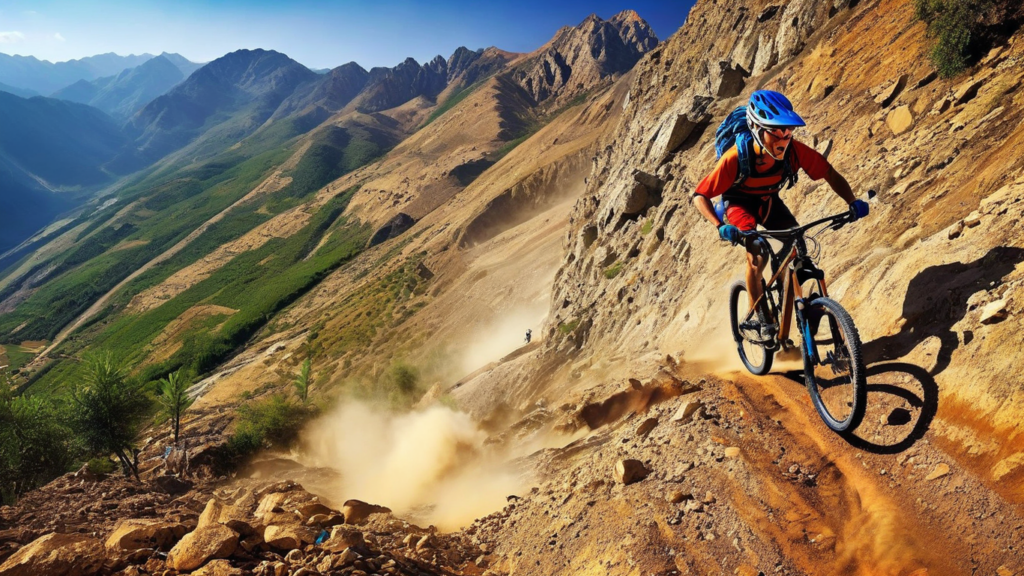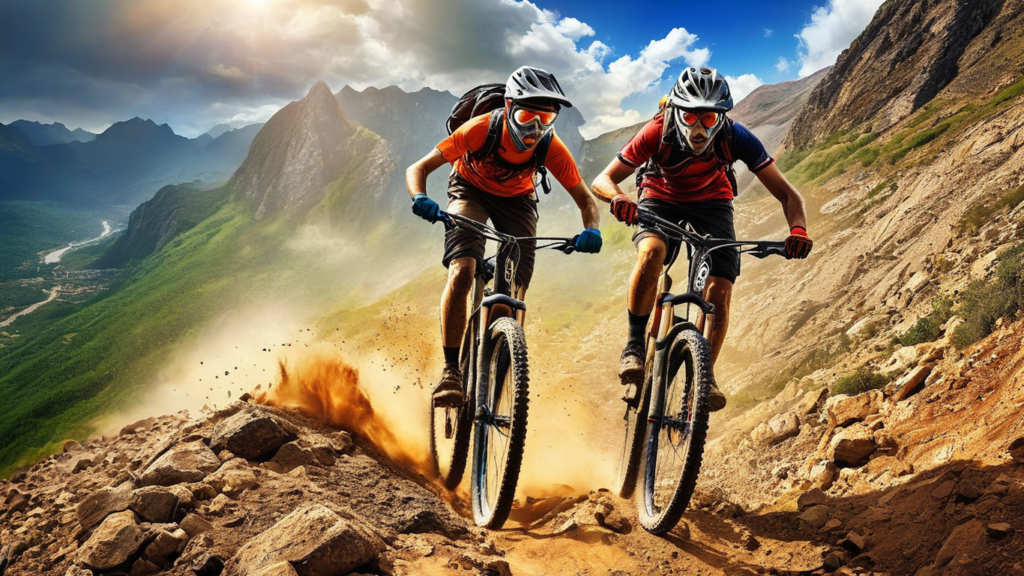
Review of Best Mountain Bikes
For those seeking an affordable entry into the world of mountain biking, there is no need to break the bank on a high-end model.
Whether you are a newcomer to the sport or a casual rider who sticks to less challenging trails, budget-friendly mountain bikes offer plenty of performance.
With most options in the sub-$1,000 price range featuring 27.5-inch or 29-inch wheels, front suspension, and aluminum frames, there are numerous suitable choices available.
Here, we highlight the best mountain bikes under $1,000 for 2025, catering to both first-time and long-time riders.
Our Top Picks of The Best Mountain Bikes Under $1,000
- Hardtail mountain bike for a high-performance ride on rugged trails, 29-inch wheels with a medium frame fit riders 67 to 70 inches tall
- Lightweight aluminum frame features internal cable routing for a sleek look, 141 mm rear hub spacing creates a more stable and rigid hardtail
- Dual suspension mountain bike for trail riders looking for comfort and performance on technical terrain, 29-inch wheels with a medium frame fit riders 67 to 70 inches tall
- Mongoose Horst link 100 mm travel aluminum trail frame minimizes suspension lockout while braking and reduces chain tension through the travel cycle
- The Schwinn Moab 3 is for the rider who wants to get serious about XC mountain biking
- Schwinn mountain-tuned N LITENED 2 aluminum frame and SR Suntour XCT30 DS 100mm fork provide a lightweight, responsive ride
- Tectonic T1 aluminum frame for lightweight durability
- Mongoose MTB saddle keeps you comfortable on long rides
- ✅POWERFUL ELECTRIC SYSTEM:With removable 48V/374Wh battery, you can pedal assist to 55 miles per charge using the low pedal assist level. 500w brushless geared motor (Peak 750W) provides reliable support and 20-22MPH top speed. providing more than enough to power your daily commute, a cruise on the mountain, or a meander along your favorite trail. You can easily handle most of the hillsides encountered.
- ✅4 WORKING MODES: PAS Mode(Pedal Assist) : The motor will assist you with a moderate amount of power as you pedal the bike, kick in 1 of 5 levels pedal assist to meet your needs. Throttle Mode:You can switch LCD Display to 1-5 level, and then use the throttle to achieve up to 20-22MPH. Cruise Mode: Keep the throttle at a speed of 10km/h. Long press “-” key to enter a fixed speed cruise in three seconds. Pure pedal Mode:Pedal the bike normally as you would any bike.
- 【1200W Peak Powerful Motor with 3 Riding Modes】Our 750w(Peak 1200W) high-speed brushless rear motor provides strong power and is less prone to damage. Electric bike provides 3 riding modes: Pure electric mode, pedal-assist mode, classic bike mode. With a max speed of up to 28+MPH in pedal-assist mode; 20 MPH by throttle , combined with the Tender 26″x4.0″ all-terrain fat tire, you can conquer all kinds of rough terrain, including snow, beach, rugged mountain roads, etc.
- [LARGE CAPACITY LG CELLS BATTERY]Ebike equips with 48V 15AH large capacity LG cells battery,which provides 4 hours fast charge. It covers a range of 25-40+ miles per full charge. The battery is removable, hidden, waterproof and convenient to bring home or office for charging.
- Durable 15 inch steel mountain frame and front suspension fork to take on bumps and drops with ease, 24-inch wheels, Riders Ages 8+, Suggested height 4’8” to 5’6”
- 18-speed twist shifters and rear derailleur guarantee consistent and seamless shifting
- 26-inch full suspension aluminum MTB frame
- Suspension fork 65mm travel

Top 7+ Best Mountain Bikes Under $1000
Numerous good choices exist under $1,000, and the top picks for 2025 are listed below. For additional details, refer to the comparison table and purchasing tips that follow.
Co-op Cycles DRT 1.2
- Suspension: 120mm (front)
- Tires: 27.5 x 2.4 in. (medium frame)
- Gears: 2 x 9
- Pros: Attractive pricing, solid performance on trails, and REI’s reliable warranty.
- Cons: Outdated 2X drivetrain.
Formerly known as Novara, REI’s Co-op Cycles presents an extensive range of budget-friendly hardtail mountain bikes.
The DRT 1.2, priced just under $1,000, appeals to both novice and more experienced riders with its stable 2.4-inch tires, thru-axles for enhanced rigidity, and a generous 120 millimeters of front suspension.
Additional features like internal cable routing for a neater appearance and a setup ready for a dropper post (sold separately) add considerable value.
Though weighing over 32 pounds, the DRT 1.2 is less agile and quick compared to some other models on this list (such as the Specialized Rockhopper below).
Despite this, its 2 x 9 drivetrain, while somewhat old-fashioned, operates smoothly and tackles inclines effectively.
Overall, the DRT 1.2 offers the necessary features for mild trail riding and comes with REI’s excellent warranty coverage. For those looking for a more basic option, consider the $599 DRT 1.1 also from Co-op Cycles.
Cannondale Trail 5
- Suspension: 100mm (front)
- Tires: 29 x 2.25 in. (medium frame)
- Gears: 1 x 10
- Pros: Updated geometry and varied wheel sizes for shorter riders.
- Cons: Less comfortable on rough trails.
Cannondale is expanding its range with electric bikes, but its Trail series remains a standout for affordability. The Trail 5 features modern, longer, and more relaxed geometry at a price of $960. It comes equipped with a 1 x 10 Microshift drivetrain, reliable hydraulic disc brakes, and a sleek design with internal cable routing.
The Trail 5 directly competes with the Giant Talon (described below), boasting a competitive price and broad availability. Both bikes offer similar specs, making the choice between them a close one. However, Cannondale edges out slightly due to a better gear range and more frequent discounts.
Marin San Quentin 1
- Suspension: 130mm (front)
- Tires: 27.5 x 2.6 in. (medium frame)
- Gears: 1 x 9
- Pros: Bold, trail-ready design at a competitive price.
- Cons: Challenging for climbs; possibly too slack for beginners on rolling terrain.
Marin’s San Quentin 1 departs from traditional sub-$1,000 mountain bike designs with a bold build and advanced geometry reminiscent of more expensive models. Its standout features include a very slack 64-degree head angle and wide 2.6-inch tires, enhancing comfort on steep descents. Despite its prowess downhill, its geometry makes uphill rides less comfortable, particularly on steeper climbs.
Giant Talon 1
- Suspension: 80 or 100mm (front)
- Tires: 29 x 2.4 in. (medium frame)
- Gears: 1 x 10
- Pros: Sleek design and high-quality drivetrain.
- Cons: Somewhat dated geometry; limited suspension options.
Giant’s Talon 1 shines among budget mountain bikes with its Shimano Deore 1 x 10 drivetrain and wide, 2.4-inch Kenda Booster tires.
Though not tubeless-compatible, these features, along with an air-sprung fork and hydraulic disc brakes, make it an attractive choice for aspiring cross-country riders.

Specialized Rockhopper Comp 29
- Suspension: 90 or 100mm (front)
- Tires: 29 x 2.35 in. (medium frame)
- Gears: 1 x 9
- Pros: Excels in cross-country terrain; lightweight and adaptable.
- Cons: Less effective on rocky and root-filled trails.
Specialized is renowned for its high-quality bikes, and the Rockhopper Comp 29 is no exception. Priced at $950, it offers a well-rounded design with a focus on moderate cross-country trails. While it performs well on smooth trails, its quick-release axles may lack stiffness on more technical routes.
Co-op Cycles DRT 1.1
- Suspension: 100mm (front)
- Tires: 27.5 x 2.1 in. (medium frame)
- Gears: 3 x 7
- Pros: Excellent value for the price.
- Cons: Heavier and less agile on the trail.
The DRT 1.1 serves as a more affordable alternative within the Co-op Cycles lineup, designed for gravel paths and light trail use.
While its components are less advanced, its solid construction and overall functionality offer great value, especially for casual riders.
Diamondback Line 27.5
- Suspension: 120mm (front)
- Tires: 27.5 x 2.35 in. (medium frame)
- Gears: 1 x 9
- Pros: Sturdy build and comfortable handling.
- Cons: Previous versions offered a more aggressive design.
Diamondback’s Line 27.5 remains a favorite for budget-conscious riders seeking a durable and well-equipped bike. Recent changes include a switch from thru-axles to less robust quick-release hubs, and a downgrade in tire quality. Despite these changes, it maintains its appeal for trail and cross-country use.
Trek Marlin 5
- Suspension: 80mm – 100mm (front)
- Tires: 29 x 2.2 in. (medium frame)
- Gears: 2 x 8
- Pros: Versatile design suitable for XC trails, bike paths, and commuting.
- Cons: Less suitable for challenging trail conditions.
Trek’s Marlin 5 combines good looks with functional features, such as rear rack mounts and a range of frame sizes.
Its updated Shimano 2 x 8 drivetrain enhances its suitability for mixed-use applications, making it a strong contender for those who also commute or tour.
However, for more demanding trail use, a higher budget may be necessary to find a more capable bike.

Mountain Bike Frame Materials
The Budget-Friendly Aluminum Frame
In the market for mountain bikes under $1,000, aluminum dominates due to its balance of cost, weight, and manufacturability. Most entry-level mountain bikes, such as the Co-op Cycles DRT 1.2, sport aluminum frames, appreciated for their light weight and durability. These bikes are sufficiently stiff to handle rough trails and withstand common accidents without severe damage. However, aluminum isn’t perfect; it tends to offer a stiffer ride, which can be harsh on rough terrains as it absorbs less vibration compared to softer materials like carbon fiber or steel. Additionally, aluminum frames can suffer from fatigue over time, with welds potentially cracking after extensive use. Nevertheless, for budget-conscious cyclists, aluminum remains a top choice due to its longevity and performance capabilities.
Comparing Steel and Carbon Fiber Options
While steel is noted for its durability and strength, making it ideal for long-term heavy usage, it is heavier and less common in budget mountain bikes due to its weight. On the other hand, carbon fiber frames are lighter and provide smoother ride quality but are significantly more expensive to produce, often found in bikes well above the $1,000 price point.
Mountain Bike Suspension
Navigating Suspension Choices on a Budget
The majority of sub-$1,000 mountain bikes are designed with front suspension forks, which provide between 75 and 120 millimeters of travel. This design, known as a “hardtail,” lacks rear suspension, which helps keep costs and maintenance down but limits the bike’s effectiveness on very rough trails. Bikes like the Co-op Cycles DRT 1.1 offer 100mm of travel, which is suitable for light to moderate trails. Those looking for more robust options might consider models like the Marin San Quentin 1, which offers up to 130mm of fork travel, providing a more capable ride on diverse terrains.
Considerations for Full-Suspension Bikes
Full-suspension bikes, which include both front and rear shocks, typically start at higher price points due to the additional complexity and materials. At the sub-$1,000 level, any full-suspension options are likely to involve significant compromises in weight, component quality, and performance.
Wheel Size: 27.5 vs. 29er
The Evolution of Wheel Sizes
The industry has largely moved away from the traditional 26-inch wheel to larger sizes, such as 27.5-inch and 29-inch, which offer better traction, stability, and rollover capability. Both wheel sizes are prevalent in the under $1,000 category, with 29-inch wheels generally providing better performance on climbs and rugged terrains, while 27.5-inch wheels offer quicker handling. The choice between the two often comes down to personal preference and riding style, with smaller riders sometimes favoring 27.5-inch wheels for better fit and manageability.
Bike Weight Considerations
The Trade-off Between Weight and Cost
Aluminum hardtails with front suspensions are the go-to for budget-conscious riders looking for a balance between weight and cost. Typically, these bikes weigh around 30 pounds, which is manageable for most recreational uses. However, as price decreases, the overall weight of the bike tends to increase due to heavier components being used, which can affect handling and fatigue on longer rides.
Drivetrain and Gears
Simplifying the Gear System
For riders on a budget, finding a bike with a simplified drivetrain, such as a 1 x 10 or 2 x 9 setup, can provide sufficient gearing for all-mountain riding without the complexity and weight of more gears. This configuration is easier to maintain and reduces the chance of mechanical issues on the trail.
Brakes
The Importance of Reliable Stopping Power
Modern mountain bikes under $1,000 increasingly feature disc brakes, which offer significant improvements in stopping power and reliability over older rim brakes. This advancement is crucial for maintaining control in muddy or wet conditions and ensures safer, more confident riding.
Unisex vs. Women’s-Specific Mountain Bikes
Tailoring Bikes to Rider Needs
While most budget mountain bikes are unisex, there are specific models tailored to women. These bikes may feature adjustments such as a lower standover height, narrower handlebars, and women-specific saddles, which can make a significant difference in comfort and control for some riders.
Exploring Fat Bikes
The Unique Appeal of Fat Bikes
Fat bikes, with their wide tires, offer exceptional grip and stability, making them ideal for snow-covered or sandy trails. While heavier and slower than standard mountain bikes, they provide a distinct riding experience that can be particularly enjoyable for casual, off-season cycling.
What Do You Get by Spending More?
Benefits of Increasing Your Budget
Investing more into a mountain bike can significantly enhance the quality and performance of the ride. Higher-priced models often feature full-suspension setups, lighter materials, and better components, which translate to improved durability, comfort, and overall trail performance.
Buying a Mountain Bike Online
Tips for a Successful Online Purchase
Online bike purchases have become more common, offering convenience and often better prices. However, it’s crucial to ensure the correct fit and consider factors like assembly requirements and shipping fees. Online tools like size calculators and detailed product descriptions can help buyers make informed decisions and avoid common pitfalls.
Are Used Mountain Bikes Worth It?
Considering Second-Hand Options
Purchasing a used mountain bike can be a great way to save money while still getting a high-quality ride. Key considerations include the bike’s condition, age, and compatibility with current components. While there are risks, such as potential hidden damage, buying from reputable sources or local shops can offer additional security and value.
This comprehensive guide aims to provide cyclists with the necessary information to make informed decisions when exploring mountain bikes under $1,000, whether buying new, used, online, or in-store.
FAQS About Mountain Bikes
What are the key features to look for in a mountain bike under $1,000?
When shopping for a mountain bike under $1,000, look for features such as a durable aluminum frame, reliable front suspension, and a drivetrain that offers a range of gears. Wheel size is also important, with 27.5-inch or 29-inch options available. Other aspects to consider include hydraulic disc brakes for better stopping power and internal cable routing for a cleaner setup.
What is the difference between a hardtail and a full-suspension mountain bike?
A hardtail mountain bike has a suspension fork at the front but no rear suspension, making it lighter, less expensive, and easier to maintain. Full-suspension bikes, which have both front and rear suspension, offer better control and comfort on more technical and rough terrain. However, they are typically more expensive and heavier.
How important are the tires on a mountain bike?
Tires are crucial for mountain biking as they directly affect grip, control, and comfort on different terrains. For mountain bikes under $1,000, look for wider tires (around 2.25 to 2.6 inches) which provide more stability and traction. The tread pattern should also suit the specific type of terrain you plan to ride on, whether it’s muddy, rocky, or loose surfaces.
Can I upgrade components on a budget mountain bike?
Yes, components on budget mountain bikes can often be upgraded to improve performance. Common upgrades include the drivetrain, brakes, and suspension fork. However, it’s important to consider the overall cost of upgrades, as investing too much into a budget frame may not always be cost-effective in the long run.
What maintenance does a mountain bike require?
Regular maintenance is key to ensuring the longevity and performance of a mountain bike. This includes cleaning the bike after muddy rides, regularly checking and adjusting the brakes and gears, lubricating the chain, and ensuring that all bolts are tight. It’s also wise to have the suspension checked annually by a professional.
How do I choose the right size mountain bike?
Choosing the right size mountain bike involves considering both the frame size and the wheel size. Frame size is typically based on your height and inseam length, and most manufacturers provide a size chart. Riding a bike that fits properly enhances control and comfort, reducing fatigue and the risk of injury.
What are the benefits of 29-inch wheels on a mountain bike?
29-inch wheels, commonly referred to as “29ers,” offer several advantages, especially on cross-country mountain bikes. They roll over obstacles more easily than smaller wheels, provide greater traction and stability due to a larger contact area, and maintain momentum better. These features make them ideal for longer rides on varied terrain.
Are there specific mountain bikes for women?
Yes, many brands offer women-specific mountain bikes which are designed with a geometry that better fits the average female body. These bikes often feature shorter reach lengths, lower standover heights, and components like saddles and handlebars that are tailored for women, providing a more comfortable and ergonomic ride.
What should I carry with me on mountain bike rides?
When going on mountain bike rides, it’s important to carry a few essentials for both safety and maintenance. This includes a helmet, a hydration pack or water bottle, a basic tool kit, a spare tube or a patch kit, and a pump. For longer or more remote rides, consider bringing snacks, extra water, a map or GPS, and a first aid kit.









